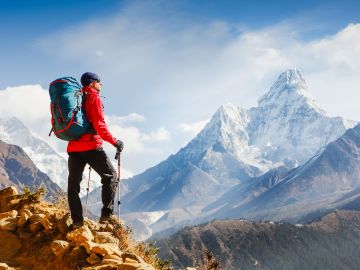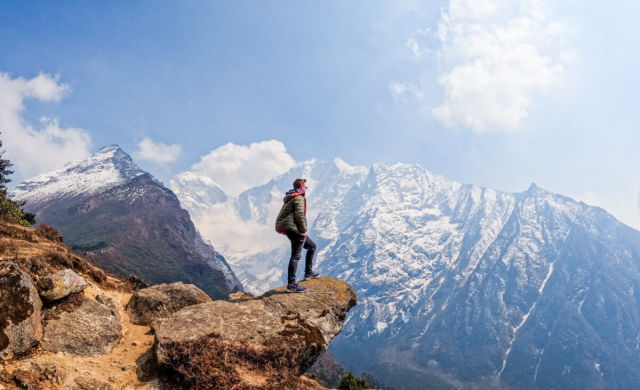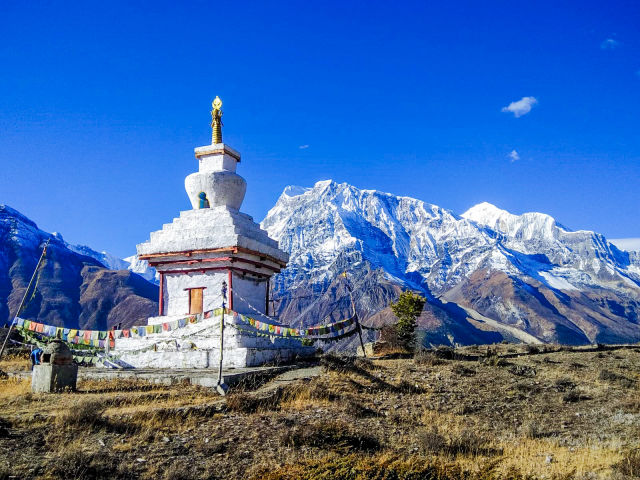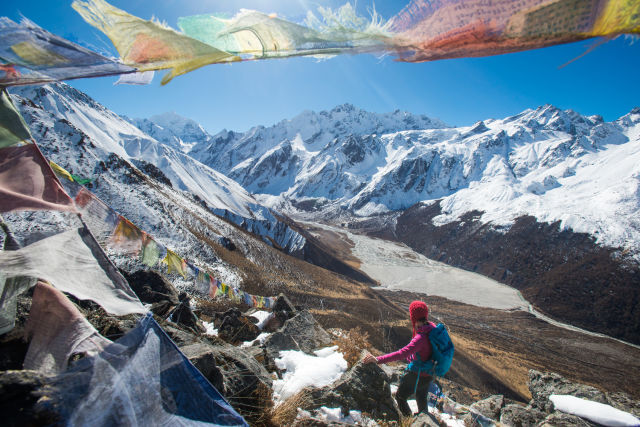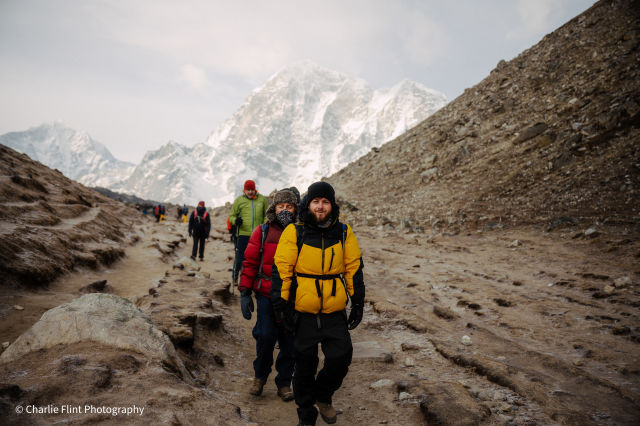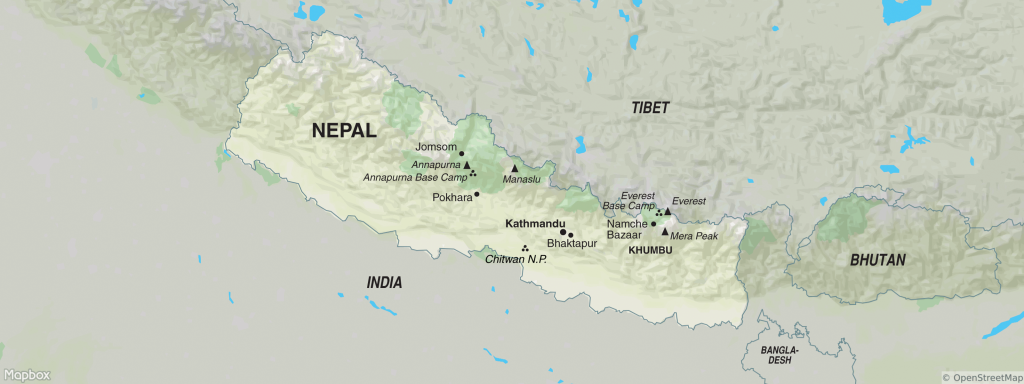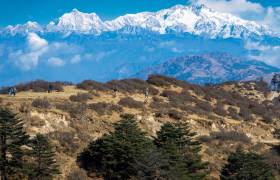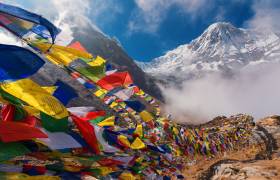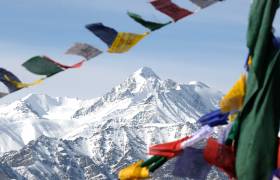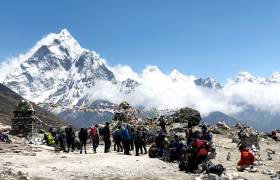High season: September to November and March to May. There are real advantages to trekking in Nepal during the high seasons. In particular, good temperatures and clearer skies present a better chance of witnessing those stunning mountain views. But there are also drawbacks. The trekking trails and teahouses are busier, and prices are higher throughout the high season. From September to November, skies are generally clear after the monsoon season, whereas April to May can see more wind and dust.
Low season: December to February: During low season, particularly December, the skies are generally at their clearest — both in the cities and the mountainous areas because humidity is low. If you come prepared for cold weather up in the mountains, then trekking in the winter can be extremely rewarding. December has some of the clearest skies and views and the trails and lodges are much quieter.
There’s no denying, Nepal walking holidays require a good level of fitness to fully enjoy the experience and ensure your personal safety. Trekking in Nepal often involves traversing steep, rugged terrains, adjusting to high altitudes and withstanding severe weather conditions, all of which can be physically demanding. Because of the challenges you’ll face when trekking in Nepal, it’s recommended that you prepare by doing cardiovascular exercises to build endurance. Strengthening exercises can also help your legs, back and core muscles when navigating demanding trails and carrying a day pack. You may want to try some lower-altitude treks in Nepal or other European destinations before tackling more challenging heights. For more information about the activity level of the trip you intend on taking, look at the grades that have been given to the specific tour.
Trekking solo without a guide is not permitted in Nepal. Hiking with an expert guide ensures better health and safety in the mountains, while also boosting tourism, giving vital income to leaders, guides and local Nepalese businesses. At Exodus, your safety is of utmost importance to us, which is why we’d recommend travelling with our expert guides, who have years of experience guiding in Nepal. We provide one of the highest ratios of guides to clients on our Nepal walking holidays, so you can feel safe in the knowledge that there are medical supplies and professional assistance on hand if needed. Our Nepal guides are highly experienced and as well as providing vital support and resources, they also possess unparalleled knowledge about the culture and history, giving you invaluable local insights.
All our trip notes have a kit list, which details the essential items required. Essential means ‘essential’ and is what you really should not travel without. Kit bags have a weight limit of 10kg as a porter will be carrying two bags so pack well but pack light. Here are some essential kit tips:
- Hiking boots—never buy these immediately before your trek! Wear them in first.
- Sleeping bag (essential on all treks using teahouses and homestays). If the trip notes say 4-season sleeping bag, it means you need a 4-season sleeping bag. Don’t skimp on the warmth.
- A daypack for your water bottle, small snacks, fleece, waterproofs and other daily essentials
- Warm jacket – the warmth depends on the time of year so check the trip notes.
- Waterproof jacket and trousers
- Good-quality base layer (merino wool is a good choice)
- Quick-dry shirts/t-shirts
- Comfortable walking socks
- Gloves
- Trekking pole(s) – test these before you go – they can save your joints on steep up/downhill sections. Practice with them before you go – they are useless and dangerous if you don’t know how to use them properly.
- Comfortable evening clothes, such as tracksuit bottoms
- Water purification tablets, which don’t weigh much or a steripen (you will need a wide-mouthed bottle if bringing a steripen)
It’s all down to personal preference but hiring the essentials and often bulky items saves on luggage space for your international travel and it also ensures you’re equipped with the right items to suit the trek (i.e. you won’t go cold with our local down jackets and sleeping bags). However, don’t forget, your hired items count as your trek kit bag weight allowance so don’t overpack on other items unnecessarily.
Nepal trekking tours in the Himalaya feature a diverse range of terrains to navigate, from the world’s highest peaks of Everest Base Camp to the tranquil lakes and dense forests of Gokyo. When trekking to Everest Basecamp, you’ll face rugged terrain with steep ascents and rocky paths, while Manaslu Circuit is home to forested slopes and high mountain passes. When walking the Annapurna Circuit, you’ll climb many stone staircases and five modern suspension bridges. Langtang is home to more remote and adventurous trails with lengthy ascents and descents along rocky paths.
Teahouses are quite basic, but they are a welcome sight after a day of trekking in Nepal. The hub of the teahouse is the dining room, which is usually decorated with colourful, traditional rugs, sometimes with a stove or heater to gather around in the evenings. Most teahouses sell snacks and other essentials such as tissues, soap and toilet paper. On our trekking holidays in Nepal, you’ll stay in twin-share bedrooms, which come with foam mattresses, bedsheets and a pillow. Remember to bring (or hire) a sleeping bag as rooms are unheated so can get cold at night. There are common toilets and showers – most of which are now inside and western style (although some at the very high altitudes are still squat type).
Many of our treks in Nepal use domestic flights to reach the trekking areas. The flight times are generally short, between 20 – 40 minutes in the air depending on the route. In response to concerns over this safety record, Exodus arranges for independent air safety auditors to visit Nepal annually to assess the suitability of the available carriers. We then restrict our use to only those approved as part of this audit. In emergencies, we will need to use helicopters, so we also have a list of approved helicopter carriers.
When trekking at altitude there is a risk of being affected by Acute Mountain Sickness. Some of our Nepal treks stay under 2,2000m, where altitude is not an issue, but the majority reach over 3500m where you can start to feel the effects. On all our treks above 3500m we carry emergency oxygen, and all our leaders are first-aid trained and carry a first-aid kit. Our itineraries are designed to enable everyone to acclimatise to these altitudes, but you should be aware that it is still possible for you to be affected. The drug Diamox (also known as acetazolamide and normally only available on prescription) has been shown to aid acclimatisation in some individuals and therefore may reduce the risk of AMS. Clients considering using Diamox should speak to their doctor about the drug, its side effects and a prescription. There are no required vaccinations, however, recommended vaccinations include tetanus, typhoid, hepatitis A, hepatitis B, cholera, Japanese encephalitis, rabies and tuberculosis.
Although most lodges have almost identical menus, they are reasonably extensive and offer a varied selection, ranging from traditional Nepalese dhal bhat to pizza and apple pie. Dhal bhat is the staple diet in Nepal and comes in many different forms but generally comprises curried lentils and meat or vegetables, some rice and a pickle/chutney. Another popular snack is momos – a Nepalese dumpling (fried or steamed) that’s filled with meat or vegetables. Meat is available in the teahouses, but we advise against eating it on treks. Meat is often carried in the heat for several days before reaching the lodges and can cause stomach upsets or illness. Germs can also be spread by handling dirty money; therefore, we recommend using hand sanitiser.
We strongly encourage you not to buy bottled water on our treks as this contributes to the growing problem of plastic pollution in Nepal. The teahouses sell boiled water, which should not require treatment. Alternatively, all teahouses provide free cold water. This should not be drunk untreated, so we recommend you bring a reusable bottle/water bladder/CamelBak (ideally two and wide mouth) and use an effective form of water treatment. There are a wide range of products available including Steripens or purification tablets, which are the quickest and easiest options to use on a trek – we also recommend talking to an outdoor retailer for the latest advice as technologies are improving all the time. Make sure to check the product’s performance in cold/freezing conditions and consider battery life (lithium batteries are best in cold conditions).
Roads in Nepal are generally underdeveloped, windy and susceptible to heavy traffic of transit buses and trucks. Journeys can take anything from 5- 12 hours depending on the route. Some significant routes are undergoing major construction for new roads, but progress is slow, and you will often be driving off road, alongside the works for a good part of the journey.
Prices of food and amenities in teahouses generally become more expensive the higher altitude/more remote you are and access to ATMs/money changes are extremely limited. Please allow 4,400-5,800 rupees (US$33-US$44) per day for lunch, dinner, snacks, drinks, showers, toilet roll and charging on trek, and for meals not included in Kathmandu. This amount is given as a rough guideline only.
